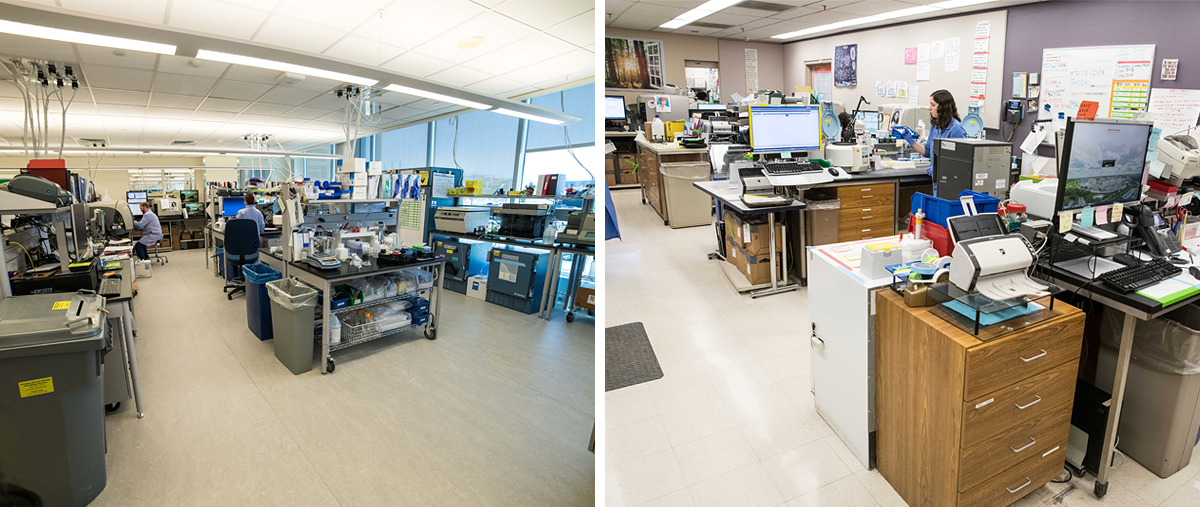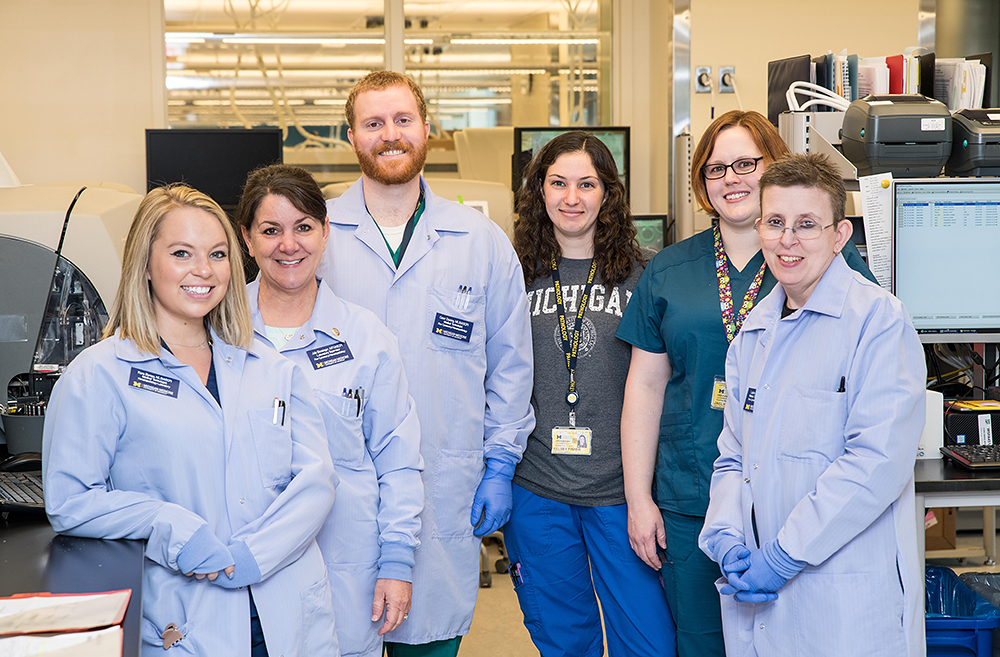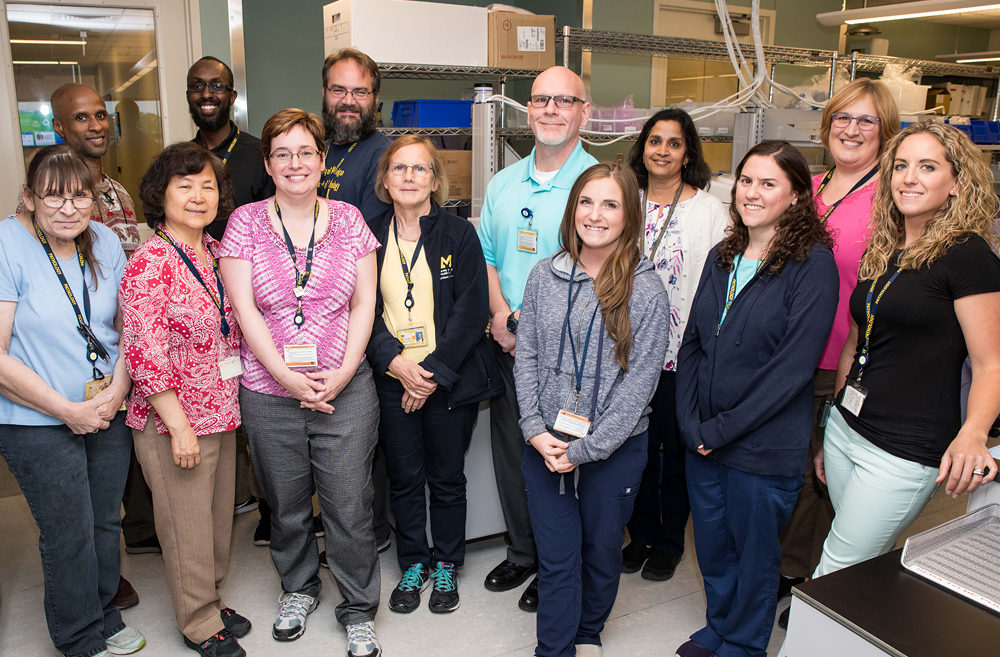Clinical Flow Cytometry Laboratory Makes Move from UH to NCRC
By Elizabeth Walker | July 11 2019n
It began with a vision. Dr. Riccardo Valdez, Director of Clinical Pathology, was interested in moving the Clinical Flow Cytometry lab from University Hospital (UH) to the HLA laboratory at the North Campus Research Complex. The shift would allow for putting similar technologies, like HLA flow and crossmatch and hemepath flow, together. It would also move the laboratory to where cases are signed out and to where marrow aspirates are stained, differentiated, and signed out.
The move was first proposed in the fall of 2018 and deemed possible. Then, the hematopathology team, led by Usha Kota and Julie Bensinger; the HLA team, led by Abdulkadir Abdulle; Clinical Pathology Operations Director, Kristina Martin; and the Pathology Relocation and Renovation (PRR) team went to work in planning for and implementing the move.
 Multiple lean process flow sessions were held to evaluate the best layout for both the HLA teams and Flow team with all groups making changes, developing compromises, and working together for the best overall solution. “Once the layout was set, numerous facilities teams needed to work together to make the change happen. This even involved one week where significant electrical and mechanical work was done in parallel to the on-going HLA lab work,” says Christine Baker, PRR Project Manager.
Multiple lean process flow sessions were held to evaluate the best layout for both the HLA teams and Flow team with all groups making changes, developing compromises, and working together for the best overall solution. “Once the layout was set, numerous facilities teams needed to work together to make the change happen. This even involved one week where significant electrical and mechanical work was done in parallel to the on-going HLA lab work,” says Christine Baker, PRR Project Manager.
The teams also worked with PRR to identify storage solutions. To fit Flow Cytometry into space formerly occupied by only HLA, both teams needed to develop more lean approaches to storage and supply management.
As part of the move, the Flow Cytometry lab worked with the Blood Bank to hand off STAT stem cell testing that could not be moved to NCRC. “The Cell Therapy team within the Blood Bank had to take on a new testing paradigm for them,” explains Baker. This involved instrumentation that was new to them and new testing protocols to learn. The team did this while short-staffed and managing their own workload. The Flow Cytometry lab validated instruments and trained the Blood Bank staff on testing, trained personnel from marrows and HLA to work in hemepath flow, and trained personnel from HLA to assist with marrows receiving and staining slides. Flow Cytometry senior staff worked with vendors to assist with instrument moves, installation, and inspection, and performed validations in HLA and Flow with the data approved by section directors.
 The result? A phased move that began in April, brought specimens to NCRC beginning May 14, and was completed in late May. The teams are still working with PRR on the transport of cases to sign out, both from University Hospital to NCRC and within the NCRC complex itself, but the bright, open space in the new combined HLA and Flow Cytometry lab is better-configured for the workflow than UH where the team worked in segmented, smaller spaces. Meetings with the Flow Cytometry director are now easier, as everyone is now in one building. This is improving work life for faculty who now have better access to the laboratory and for staff, who have access to better schedules and to better parking options.
The result? A phased move that began in April, brought specimens to NCRC beginning May 14, and was completed in late May. The teams are still working with PRR on the transport of cases to sign out, both from University Hospital to NCRC and within the NCRC complex itself, but the bright, open space in the new combined HLA and Flow Cytometry lab is better-configured for the workflow than UH where the team worked in segmented, smaller spaces. Meetings with the Flow Cytometry director are now easier, as everyone is now in one building. This is improving work life for faculty who now have better access to the laboratory and for staff, who have access to better schedules and to better parking options.
An additional benefit is that when the technologist for marrows is unavailable due to a vacation or sick day, Flow Cytometry personnel are now trained to cover. The team is continuing to work on cross-training in both HLA and Flow to improve turn-around times and even out the workload, and working to reduce redundant work in order to address increased workload without adding full-time employees. This project is another exciting example of lean design and the ways the new space at NCRC is having a positive impact on faculty, staff, and patients alike.
 ON THE COVER
ON THE COVER
 ON THE COVER
ON THE COVER
 ON THE COVER
ON THE COVER
 ON THE COVER
ON THE COVER
 ON THE COVER
ON THE COVER
 ON THE COVER
ON THE COVER
 ON THE COVER
ON THE COVER
 ON THE COVER
ON THE COVER
 ON THE COVER
ON THE COVER
